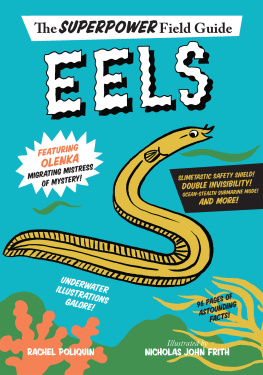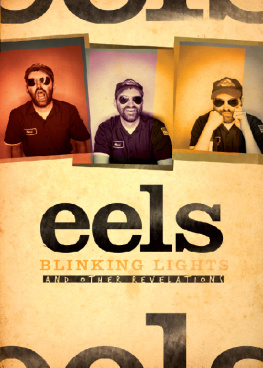Patrik Svensson - The Book of Eels: Our Enduring Fascination with the Most Mysterious Creature in the Natural World
Here you can read online Patrik Svensson - The Book of Eels: Our Enduring Fascination with the Most Mysterious Creature in the Natural World full text of the book (entire story) in english for free. Download pdf and epub, get meaning, cover and reviews about this ebook. year: 2020, publisher: HarperCollins, genre: Detective and thriller. Description of the work, (preface) as well as reviews are available. Best literature library LitArk.com created for fans of good reading and offers a wide selection of genres:
Romance novel
Science fiction
Adventure
Detective
Science
History
Home and family
Prose
Art
Politics
Computer
Non-fiction
Religion
Business
Children
Humor
Choose a favorite category and find really read worthwhile books. Enjoy immersion in the world of imagination, feel the emotions of the characters or learn something new for yourself, make an fascinating discovery.
- Book:The Book of Eels: Our Enduring Fascination with the Most Mysterious Creature in the Natural World
- Author:
- Publisher:HarperCollins
- Genre:
- Year:2020
- Rating:3 / 5
- Favourites:Add to favourites
- Your mark:
- 60
- 1
- 2
- 3
- 4
- 5
The Book of Eels: Our Enduring Fascination with the Most Mysterious Creature in the Natural World: summary, description and annotation
We offer to read an annotation, description, summary or preface (depends on what the author of the book "The Book of Eels: Our Enduring Fascination with the Most Mysterious Creature in the Natural World" wrote himself). If you haven't found the necessary information about the book — write in the comments, we will try to find it.
Patrik Svensson: author's other books
Who wrote The Book of Eels: Our Enduring Fascination with the Most Mysterious Creature in the Natural World? Find out the surname, the name of the author of the book and a list of all author's works by series.
The Book of Eels: Our Enduring Fascination with the Most Mysterious Creature in the Natural World — read online for free the complete book (whole text) full work
Below is the text of the book, divided by pages. System saving the place of the last page read, allows you to conveniently read the book "The Book of Eels: Our Enduring Fascination with the Most Mysterious Creature in the Natural World" online for free, without having to search again every time where you left off. Put a bookmark, and you can go to the page where you finished reading at any time.
Font size:
Interval:
Bookmark:
Later in the same fields
He stood at night when eels
Moved through the grass like hatched fears
SEAMUS HEANEY
This is how the birth of the eel comes about: it takes place in a region of the northwest Atlantic Ocean called the Sargasso Sea, a place that is in every respect suitable for the creation of eels. The Sargasso Sea is actually less a clearly defined body of water than a sea within a sea. Where it starts and where it ends is difficult to determine, since it eludes the usual measures of the world. Its located slightly northeast of Cuba and the Bahamas, east of the North American coast, but it is also a place in flux. The Sargasso Sea is like a dream: you can rarely pinpoint the moment you enter or exit; all you know is that youve been there.
This impermanence is a result of the Sargassos being a sea without land borders; it is bounded instead by four mighty ocean currents. In the west by the life-giving Gulf Stream; in the north by its extension, the North Atlantic Drift; in the east by the Canary Current; and in the south by the North Equatorial Current. Two million square miles in size, the Sargasso Sea swirls like a slow, warm eddy inside this closed circle of currents. What gets in doesnt always have an easy time getting out.
The water is deep blue and clear, in places very nearly 23,000 feet deep, and the surface is carpeted with vast fields of sticky brown algae called Sargassum, which give the sea its name. Drifts of seaweed many thousands of feet across blanket the surface, providing nourishment and shelter for myriad creatures: tiny invertebrates, fish and jellyfish, turtles, shrimp, and crabs. Farther down in the deep, other kinds of seaweed and plants thrive. Life teems in the dark, like a nocturnal forest.
This is where the European eel, Anguilla anguilla, is born. This is where mature eels breed in the spring and their eggs are laid and fertilized. Here, safe in the darkness of the depths, small larva-like creatures with disturbingly tiny heads and poorly developed eyes spring to life. Theyre called leptocephalus larvae and have a body like a willow leaf, flat and virtually transparent, only a few millimeters long. This is the first stage of the eels life cycle.
The gossamer willow leaves immediately set off on their journey. Swept up by the Gulf Stream, they drift thousands of miles across the Atlantic toward the coasts of Europe. Its a journey that can take as long as three years; during this time, each larva slowly grows, millimeter by millimeter, like a gradually inflating balloon, and when at last it reaches Europe, it undergoes its first metamorphosis, transforming into a glass eel. This is the second stage of the eels life cycle.
Glass eels are, much like their willow leaf former selves, almost entirely transparent, two to three inches in length, elongated and slithery, transparent, as though neither color nor sin has yet to take root in their bodies. They look, in the words of the marine biologist Rachel Carson, like thin glass rods, shorter than a finger. Frail and seemingly defenseless, they are considered a delicacy by, among other people, the Basques.
When a glass eel reaches the coasts of Europe, it will usually travel up a brook or river, adapting almost instantly to a freshwater existence. This is where it undergoes yet another metamorphosis, turning into a yellow eel. Its body grows serpentine and muscular. Its eyes remain relatively small, with a distinctive dark center. Its jaw becomes wide and powerful. Its gills are small and almost completely concealed. Thin, soft fins stretch along the entirety of its back and belly. Its skin finally develops pigment, coloring it shades of brown, yellow, and gray, and it becomes covered in scales so tiny they can be neither seen nor felt, like an imaginary armor. If the glass eel is tender and fragile, the yellow eel is strong and sturdy. This is the third stage of the eels life cycle.
The yellow eel is able to move through the shallowest, most overgrown waters as well as the swiftest currents. It can swim through murky lakes and up tranquil streams, up wild rivers and through lukewarm ponds. When needed, it can pass through swamps and ditches. It doesnt let circumstance stand in its way, and when all aquatic possibilities have been exhausted, it can take to dry land, slithering through moist brush and grass in pushes toward new waters that can last for hours. The eel is, thus, a fish that transcends the piscine condition. Perhaps it doesnt even realize it is a fish.
It can migrate thousands of miles, unflagging and undaunted, before it suddenly decides its found a home. It doesnt require much of this home; the environs are something to adapt to, to endure and get to knowa muddy stream or lake bed, preferably with some rocks and hollows to hide in, and enough food. Once it has found its home, it stays there, year after year, and normally wanders within a radius of only a few hundred yards. If relocated by external forces, it will invariably return as quickly as it can to its chosen abode. Eels caught by researchers, tagged with radio transmitters, and released many miles from their point of capture have been known to return to where they were first found within a week or two. No one knows exactly how they find their way.
The yellow eel is a solitary creature. It usually lives out the active phase of its life alone, letting the passing seasons dictate its activities. When the temperature drops, it can lie motionless in the mud for long periods, utterly passive, and at times entangled with other eels like a messy ball of yarn.
It is a nocturnal hunter. At dusk, it emerges from the sediment and starts looking for food, eating whatever it can find. Worms, larvae, frogs, snails, insects, crayfish, fish, as well as mice and baby birds when given the chance. It is not above scavenging.
In this way, the eel lives out the greater part of its life in a brownish-yellow guise, alternating between activity and hibernation. Seemingly lacking any sense of purpose, other than in its daily search for food and shelter. As though life was first and foremost about waiting and its meaning found in the gaps or in an abstract future that cant be brought about by any means other than patience.
And its a long life. An eel that successfully avoids illness and calamity can live for up to fifty years in one place. There are Swedish eels who have made it past eighty in captivity. Myths and legends tell of eels living to a hundred or more. When an eel is denied a way to achieve its main purpose in lifeprocreationit seems able to live forever. As though it could wait until the end of time.
But at some point in its life, usually after fifteen to thirty years, a wild eel will suddenly decide to reproduce. What triggers this decision, we may never know, but once it has been made, the eels tranquil existence ends abruptly and its life takes on a different character. It starts making its way back to the sea while simultaneously undergoing its final metamorphosis. The drab and indeterminate yellowish-brown of its skin disappears, its coloring grows clearer and more distinct, its back turns black and its sides silver, marked with stripes, as though its entire body changes to reflect its newfound determination. The yellow eel becomes a silver eel. This is the fourth stage of the eels life cycle.
When autumn rolls out its protective darkness, the silver eels wander back out into the Atlantic and set off toward the Sargasso Sea. And as though through deliberate choice, the eels body adapts to the conditions of the journey. Only now do its reproductive organs develop; its fins grow longer and more powerful to help propel it; its eyes grow larger and turn blue to help it see better in the depths of the ocean; its digestive system shuts down; its stomach dissolvesfrom now on, all the energy it needs will be taken from existing fat reservesits body fills with roe or milt. No external interference can distract the eel from its goal.
Font size:
Interval:
Bookmark:
Similar books «The Book of Eels: Our Enduring Fascination with the Most Mysterious Creature in the Natural World»
Look at similar books to The Book of Eels: Our Enduring Fascination with the Most Mysterious Creature in the Natural World. We have selected literature similar in name and meaning in the hope of providing readers with more options to find new, interesting, not yet read works.
Discussion, reviews of the book The Book of Eels: Our Enduring Fascination with the Most Mysterious Creature in the Natural World and just readers' own opinions. Leave your comments, write what you think about the work, its meaning or the main characters. Specify what exactly you liked and what you didn't like, and why you think so.











